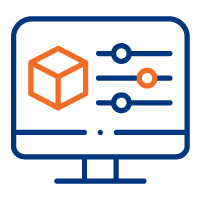Using the virtualization layer as a security gateway

Virtualization Layer: Securing Data with Accuracy
Ensuring data remains in the hands of authorized personnel is paramount for seamless business operations, but finding the delicate balance between access and security is an ongoing challenge. Stricter access policies may hinder informed decision-making, while overly liberal access rules can lead to disaster. A data virtualization layer can help you fine-tune this balance for optimal performance, enabling secure and efficient data sharing across your organization. Elevate your data strategy and empower your teams with the precision and flexibility they need for successful decision-making.
Navigating Security challenges across silos and clouds
Navigating the intricacies of sharing data across different data silos and clouds poses substantial challenges, not only from a data integration perspective but also in terms of managing access and security.
Each data source typically operates under unique security protocols and tools, and each domain has specific data access policies. While relevant at a local level, these policies create a formidable barrier to seamless data sharing across domains, further complicating this landscape. Finance, for example, has controls that are quite different from those of operations.
Moreover, clouds that host different datasets employ various tools to protect the data they store and manage, often needing more alignment or awareness of each other's existence. The enforcement of conflicting policies adds another layer of complexity. Managing configurations and procedures across all your clouds, data stores, and domains so they work together becomes overly complex, especially as data volume and demand surge.
Data virtualization serves as a robust solution to strengthen security in hybrid-cloud architectures. By bridging divides and streamlining complexities, it provides a resilient foundation for securing and managing data across diverse domains and cloud environments.
This technology offers an additional layer of security for your data, acting as a gateway when seamlessly connected to all domains and data stores. This enables streamlined, secure data access, optimizing the sharing process in a more secure manner.
Demystifying data virtualization
A data virtualization layer is an integration layer that connects to your databases wherever they reside and seamlessly merges data on the fly. Unlike ETL-based integration policies, this approach does not move data; instead, it generates virtualized representations of your data that can be easily shared, used, and analyzed.
Fortifying data security
This virtualization layer sits on top of all your databases and functions, acting as a single point of entry to all your valuable data. The virtual gateway can control data access, regulating which users can access specific data and monitoring how the data is retrieved. This single gateway simplifies and enables several security features.

Single sign-on
The virtualization layer can authenticate users and provide seamless access to all the data they are authorized to without requiring individual logins for each cloud.

Granular and role-based access controls
Since the virtualization gateway manages identities, it can also manage access rules. These rules can mask a single column within a table or manage policies that grant access to data consumers based on specific roles.

Encryption
As the single point of access, the virtualization gateway fortifies security protocols and encryption measures that underlying systems may not support.
Simplifying management
Managing a single security layer that accesses all your databases simplifies management and provides greater flexibility.

Consistent configuration
Virtualization layers can ensure consistent application of access rules across all your data stores. This capability minimizes complexity and reduces the risk of a data breach due to configuration errors.

Balance local and global policies
Data virtualization layers can inherit security features from the source database. The on-demand nature of virtualization means that security policies can be synchronized for each query, ensuring that each layer aligns with current policies. As data from different domains are integrated, virtualization layers can intelligently apply the appropriate policy.
Data stays put
The concept of data virtualization is also inherently more secure. When data stays in the source system, it is not migrated to another system for transformation, analysis, and storage. Or potentially moved to yet another system, minimizing the risk of unauthorized access associated with multiple ETL hops.
A single gateway enabled by data virtualization also allows greater visibility. It is much easier to track lineage and observe quality when data remains in place. Even if data does move, the virtualization gateway through which it travels can effectively track it. Also, each query workload enabled by the gateway can be monitored and checked for quality.
While the benefits of data virtualization technology are widespread and extend beyond security, supporting much more agile access to data, wrapping all your data with a uniform security layer simplifies data access and security management.
Request a Demo TODAY!
Take the leap from data to AI
